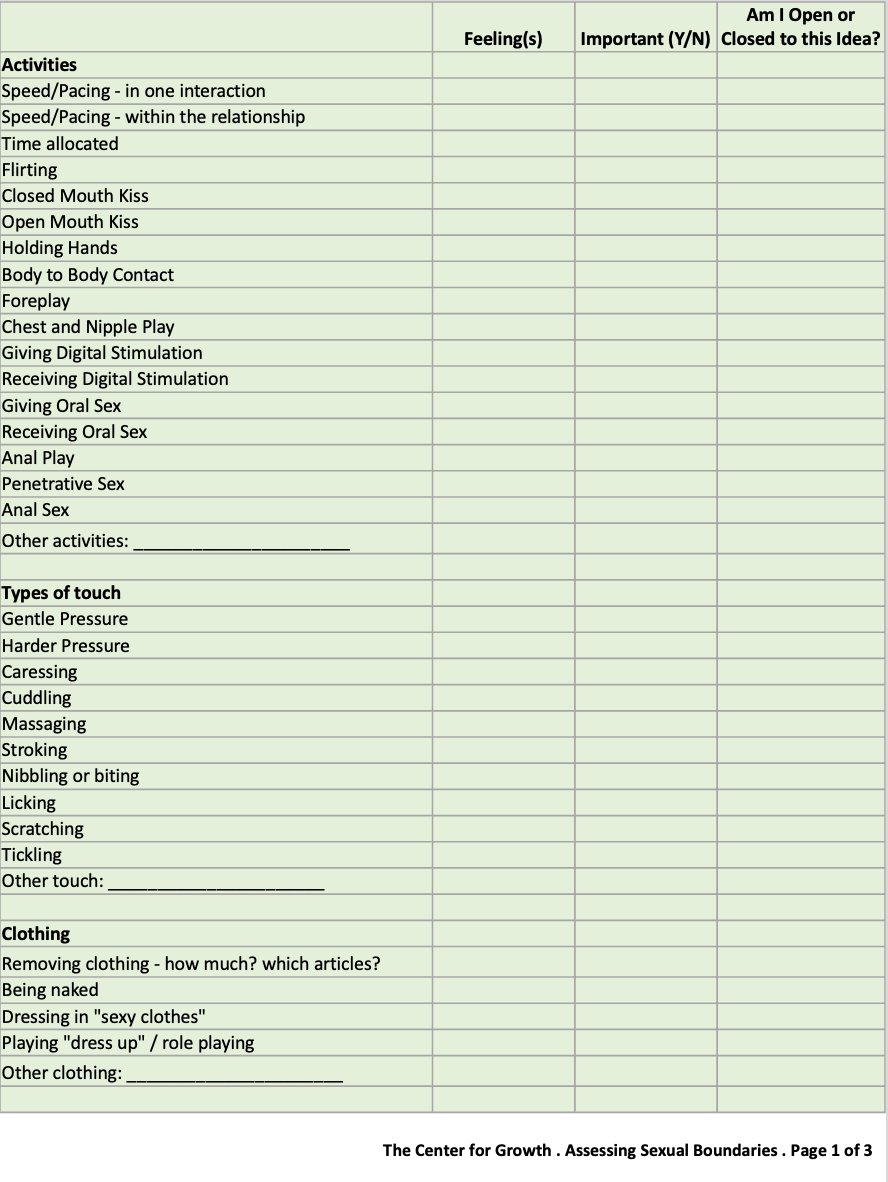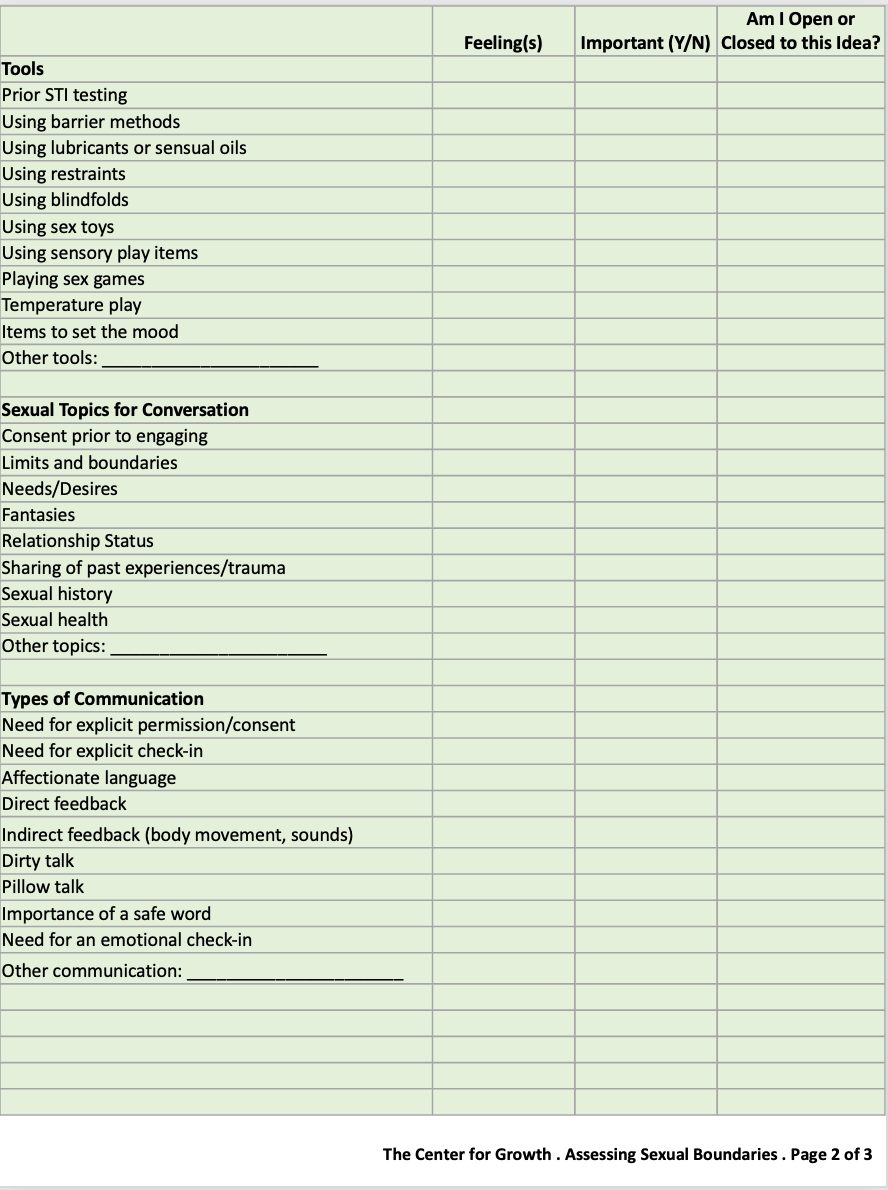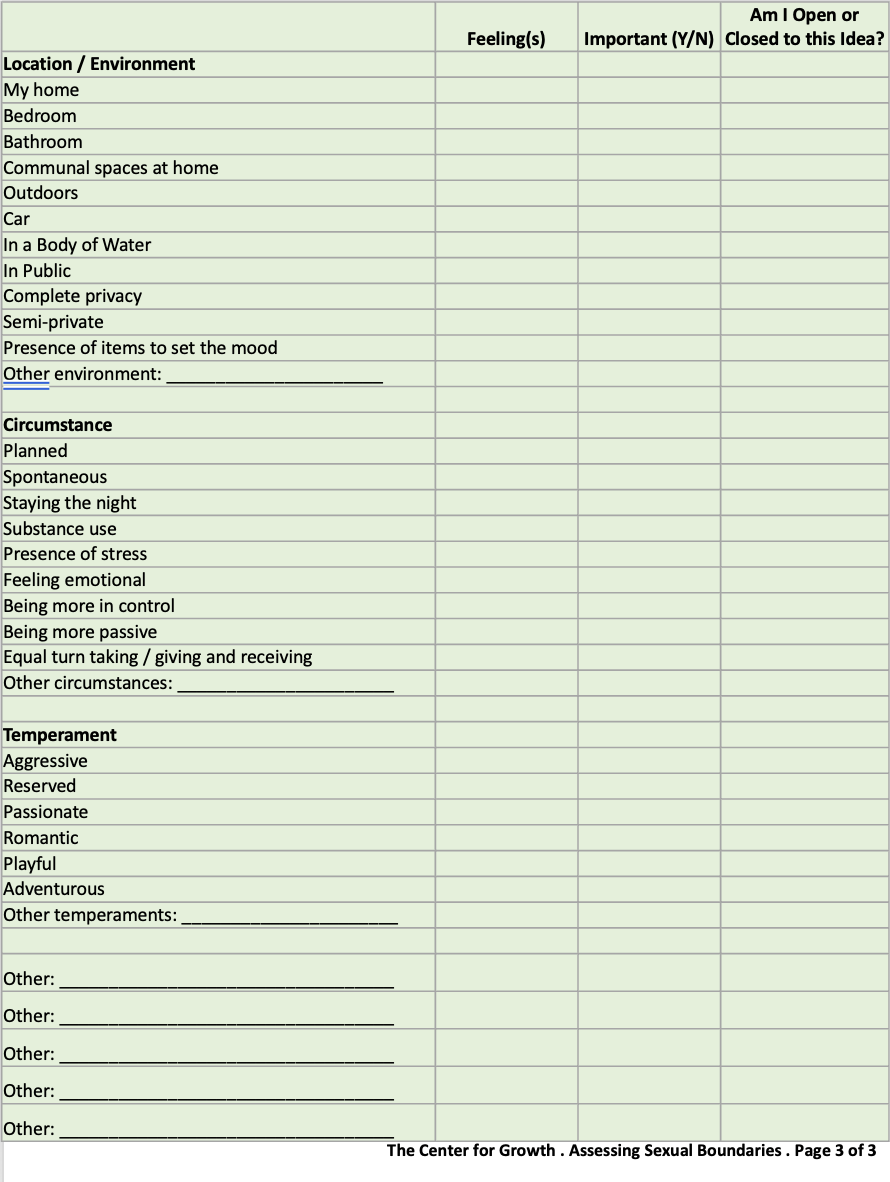
Whether you are single or in a committed relationship, assessing sexual boundaries and preferences can be difficult. Our awareness of our own individual sexuality can vary greatly based on our upbringing, education, experiences, communication, and self-exploration. Maybe sex was framed as negative, taboo, or outright discouraged during your upbringing. Maybe you lack sexual experience or have been in relationships where you have not had an opportunity to explore what you enjoy sexually. Whatever the case, it can be easy to avoid thinking about, speaking about, identifying your own needs and feelings and even understanding where you stand in relation to sex.
This article is for adults who would like to further explore their sexual preferences and limits around partnered sexual interactions. If you are looking for guidance around self pleasure, kink, or BDSM, this tip may not be for you.
For more information on the general concept of boundaries, please refer to the article, “Learning About Boundaries”. If you would like more general guidelines on how to think about boundaries, please refer to the article, “Tuning Into Boundaries”.
If you feel you have a good understanding of your sexual boundaries, and would like to explore your sexual interests in depth, check out this article on “Understanding Your Sexual Values”.
If you and your partner have thought about opening up a monogamous relationship but are looking for guidance, check out this article on “Opening Relationships”.
The Difference Between Sexual Desires and Boundaries
While sexual desires and sexual boundaries are closely related, they are their own entities.
Sexual desires are all about the different aspects of sex that we find enjoyable and arousing. This can include different types of touch, different sexual acts, and aspects of the experience that make us feel good. When sexual desires are fulfilled, our positive emotions are activated. If your sexual desires are fulfilled, you might feel relaxed, safe, satisfied, connected, excited, open, or confident.
Sexual boundaries are the invisible lines or personal shields we establish to safeguard our safety and well-being. While sexual boundaries define what we are comfortable with and what we are willing to engage in sexually, they are more so about what we are not willing to do, accept, or experience. When our sexual boundaries are crossed, our negative emotions are activated. If your sexual boundaries are crossed, you might feel sad, angry, afraid, confused, worried, uncomfortable, or unconfident.
Our sexual desires and boundaries are not fixed; just like anything else, our sexual needs can change over time. It is important to remember that what might have been okay at one point may not be okay later on. Similarly, what worked with one partner, may not work with another. Different partners all come with different energies, approaches and skill levels and it is completely normal for your personal needs and limits to shift based on the person you are with.
Why is it Beneficial to Know My Sexual Boundaries?
Setting boundaries empowers individuals to make choices about their own bodies and experiences. Having a sense of our individual boundaries before partnered interactions can help ensure our safety by giving us a sense of what our limits are and when we may need to communicate to our partner the need to slow things down or bring things to a halt. Moreover, because our boundaries are unique to us as individuals, it is very likely that your partner(s) has different needs and boundaries than you.
What Do I Consider when Assessing Sexual Boundaries?
Sexual boundaries are a vital aspect of healthy sexual relationships. They ensure that everyone involved is on the same page and excited about what's happening. Assessing sexual boundaries is all about identifying personal choices and our enthusiasm to consent in sexual and emotionally intimate activities.
Sexual boundaries refer to all matters concerning sexual intimacy and interactions. While much of the discourse has focused on consent around physical interaction, sexual boundaries encompass a whole breadth of areas including the domains listed below:
Activities
Activities encompass a wide range of physical and intimate interactions, behaviors, and experiences that people engage in for the purpose of sexual arousal, pleasure, or expression. These activities include various forms of physical contact, ranging from flirting, kissing and touching to penetrative sex. While these acts are physical in nature, they can be deeply personal and emotional.
Types of Touch
Touch refers more specifically to different types of contact and sensory experiences. Touch encompasses a wide range of sensations, from gentle caresses and light tickling to nibbling, licking, and biting.
Clothing
Clothing encompasses choices around attire and under what conditions someone might be comfortable removing clothing or dressing in a specific way for sexual intimacy. While personal style and self-expression might factor into your decisionmaking, you may consider your individual preferences for modesty or sensuality.
Tools
Tools include a range of items and resources used to enhance or protect sexual experiences. This includes barrier methods to protect against sexually transmitted infections (STIs) and unintended pregnancies. This also includes personal care items, toys, and other items that can enhance pleasure during sexual activities or set the mood, such as lubricants, sex toys, and candles.
Sexual Topics for Conversation
Sexual topics of conversation encompass various dialogues and discussions crucial for establishing, communicating, and respecting personal limits in intimate relationships. It can involve discussing consent, desires, comfort levels, safe sex, relationship status, past experiences, and any restrictions or limits within a sexual relationship. Being vulnerable with a partner(s) and engaging in open communication can ensure that you are on the same page.
Types of Communication
Communication can refer to our comfort level with speaking during sexual activity. It can also include the way you speak and like to be spoken to. While some prefer sweet nothings and romantic platitudes, others may enjoy talking dirty. Communication can also encompass our openness and willingness to give and receive feedback during a sexual encounter. Some examples of this include discussing desires, consent, comfort levels, and any restrictions or limits within a sexual relationship. It is a fundamental element in creating a safe, consensual, and fulfilling sexual experience, emphasizing mutual understanding, empathy, and the importance of respecting each individual's boundaries and preferences.
Location / Environment
Location / Environment includes the physical settings, places, and conditions in which sexual activities take place. This encompasses a range of possible locations where intimate encounters occur, such as the bedroom, bathroom, outdoors, public spaces, or even non-traditional settings like cars. It also involves considerations related to privacy, consent, legality, and the need to establish and respect boundaries to ensure safe, consensual, and comfortable sexual experiences.
Circumstance
Circumstance refers to the specific conditions, situations, and contexts in which sexual activities occur. These circumstances encompass a wide range of factors, such as the timing of sexual encounters, the emotional state of the individuals involved, and external factors like intoxication or stress. Understanding the influence of circumstances is vital for establishing and respecting personal boundaries, as they can significantly impact one's comfort, consent, and the overall safety of sexual experiences.
Temperament
Temperament is all about the tone of sexual interactions. Sex can be fun and playful. It can also be passionate and romantic. Your individual identity may play a role in your sexual temperament or it may not. For example, if you identify as someone who is more shy or conservative, you may find that you are more sexually reserved.
What Might Interfere with Assessing Sexual Boundaries?
The desires of your partner(s) might unknowingly overshadow your own needs, especially if you've been raised to prioritize their needs or are focused on making them happy. You may find yourself inclined to comply with their wishes in order to gain their approval, avoid causing emotional distress, prevent conflict, or maintain the relationship.
Your upbringing and past traumatic events can influence your reactions in scenarios where you experience ambivalence, encounter pressure, or confront conflict while establishing boundaries. If your boundaries were consistently disregarded during childhood or if you've survived sexual assault, engaging in sexual activity, such as undressing, touching, or being touched, may evoke distressing emotions. Specifically, unwelcome physical contact can serve as a catalyst, causing you to become immobilized and struggle to assert yourself.
Does My Relationship Status Impact My Sexual Boundaries?
Sexual boundaries are important no matter what your relationship status. While their specifics vary, sexual boundaries at all stages prioritize trust, respect, and intimacy to create healthy and mutually satisfying relationships. Let’s look at a few different scenarios: casual hookups, dating with the goal of transitioning into a relationship, and a long-term commitment.
In the case of casual hookups, sexual boundaries are essential for obtaining clear consent and ensuring safety, including discussions on protection and privacy.
At the beginning of a relationship, sexual boundaries help build trust and comfort, with a focus on communication, relationship goals, and respect for personal space.
In a long-term commitment, sexual boundaries maintain intimacy, guide ongoing consent, and adapt to changes in our sexual desires, fostering a fulfilling and respectful long-term partnership.
An Exercise: Assessing Sexual Boundaries.
The benefit of doing this assessment is that you can practice identifying, understanding, and listening to your boundaries. The assessment is intended to be a starting point to help you think through different aspects of sexual intimacy.
The 9 categories referenced in the article are covered broadly: Activities, Types of Touch, Clothing, Tools, Sexual Topics for Conversation, Types of Communication, Location/Environment, Circumstance, and Temperament. If you think of something you would like to add to the assessment as you are going through, please do! There is space below for you to add anything else that might be relevant to your partnered experience.
When to complete the assessment
While you can go through the assessment at any time, you may find it helpful to complete:
Before going out for the night / before a date
Before meeting up with a partner(s)
In the beginning stages of a relationship
At various stages in a relationship, as things progress physically and/or emotionally
When changing or adding partners
If any sort of negative emotions come up for you when thinking about sexual interactions with your partner(s)
After a sexual interaction that brought up difficult feelings
How to complete the assessment
For this exercise, you are encouraged to print and complete the assessment below. You will want to grab a pen and set aside some time for yourself to complete the task
- It is important that you take your specific relationship context into account. Depending on the relationship context, some of the ideas may not be applicable. For example, if you are in a long-term committed relationship, prior STI testing may not be applicable.
Is this for:A casual hookup
The beginning of a relationship
A long-term relationship
- As you go through each item, you are asked to think through:
Feelings that come up for you
The first step to assessing sexual boundaries is recognizing how you feel. Using your feelings as a guide can help you focus on yourself as an individual, rather than being overly concerned with the needs of a partner. You can identify how you feel based on your own intuition, use the mood meter, or use the word bank below.
Word bank |
How important the idea is for you
You may or may not have an opinion as you go through. That is ok and that is expected. What is most important is highlighting which ideas are most important and in what way.Whether or not you are open/closed to the idea
Your feelings about the ideas and the importance can help inform whether or not you would ultimately like to set a boundary. The binary of open and closed (no neutral option) is intentional, to help you take a stance on whether or not you need a boundary.
One thing to note as you are assessing sexual boundaries. Think about circumstances that may impact your ability to set boundaries and/or circumstances where your boundaries may change. For example, would your boundaries be impacted by alcohol/substance use?
Finally, remember that there are no right or wrong answers. It is also ok for you to think that you may not need a boundary in an area and to change your mind. Establishing our boundaries is a process of constantly checking in with yourself. It is ok to withdraw consent at any time, even in situations where we initially gave permission.
Advanced Assessment: Starting to Look At My Sexual Needs
If you are feeling comfortable discerning which areas you would like boundaries around, you can also use this assessment to identify your sexual needs and values. While negative feelings inform us of an area where we might need a boundary, positive emotions highlight our sexual desires.



To schedule a therapy appointment call 215 922 5683 or book online
- Ocean City Therapy Office
360 West Ave, Floor 1, Ocean City, NJ 08226 - Mechanicsville Therapy Office
9044 Mann Drive, Mechanicsville Virginia, 23116 - Providence Therapy Office
173 Waterman St. Providence, RI 02906 - Society Hill Therapy Office
233 S. 6th Street, C-33, Philadelphia PA 19106 - Art Museum / Fairmount Therapy Office
2401 Pennsylvania Ave, Suite 1a2, Philadelphia PA 19130 - Santa Fe Therapy Office, 2204 B Brothers Road, Santa Fe, New Mexico, 87505
- Telemedicine: We have therapists who are licensed to work in Connecticut, Florida, Georgia, New Jersey, New Mexico, Pennsylvania, Rhode Island, and Virginia.
OUR GUARANTEE: you deserve the best therapist. If you don't feel like the therapist that you met with was the right fit, then free of charge you can try out a different therapist. Being in a group practices allows for flexibility.
The Center for Growth has offices in multiple states. We offer both in person as well as virtual mindfulness therapy appointments.
The Center for Growth Therapy Offices in PA, NJ, VA, RI, NM, CT
Therapy Services Offered in Philadelphia, Ocean City, Mechanicsville, Providence, Santa Fe:
Individual Counseling and therapy
Couples Counseling and marriage counseling
Teen Therapy and Adolescent Therapy and tweens and child counseling
Family Therapy and multi-generational counseling
Art Therapy and Counseling no art skills needed
ADHD Therapy and ADD, Dyslexia, Autism, Tourettes counseling
Anxiety, Panic, OCD Therapy and worry and fear support
Breaking the cycle of Codependency and being your own person
Overcoming Chronic Illness and Chronic Pain .
Depression Therapy and sadness, gloom, and upset support
- Functional Neurological Disorder (FND) Therapy is a particular style of therapy designed for people with problems affecting their nervous system, how the brain and body send and receive signals.
- LGBTQIA+ / Queer Community Therapy Services
Grief Therapy and loss, End of A Relationship, rejections, pregnancy and loss and therapy
Mindfulness Based Therapy and spirituality based therapy
- Narcissistic Abuse Recovery child of, parent of, spouse of, sibling of a narcissist.
Sex Therapy and sexual function & dysfunction, sex addiction, sexual orientation and gender identity support
Shame and Blame
Trauma Therapy both emotional and sexual abuse, complex trauma, PTSD counseling
Divorce support
Affairs, Infidelity, Unfaithful, Cheating counseling
Parenting therapy Parenting therapy
Personality disorder therapy Personality disorder treatments
Anger Management Therapy anger therapy
Setting Boundaries and identifying ones own Core Beliefs
Just name some of the Mental Health issues that we work with. Our goal is to help you Change and Achieve Your Dreams
























